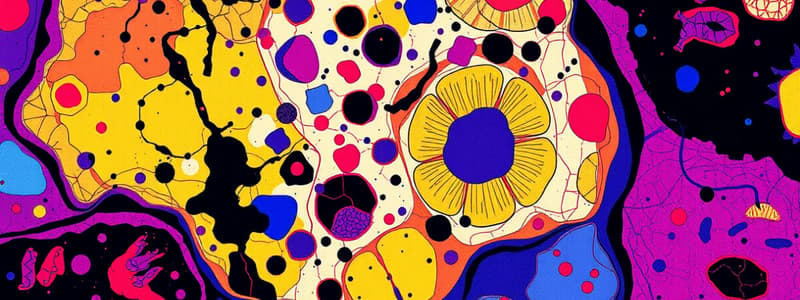Podcast
Questions and Answers
What is the primary role of the light microscope?
What is the primary role of the light microscope?
- To manipulate cellular structures for analysis
- To provide a three-dimensional view of structures
- To enhance color in specimens
- To observe objects that are too small for the naked eye (correct)
Which staining property primarily differentiates basic dyes from other types of stains?
Which staining property primarily differentiates basic dyes from other types of stains?
- Basic dyes are ineffective for cytoplasmic staining
- Basic dyes are used exclusively for nuclear stains
- Basic dyes have a net positive charge and bind to negatively charged components (correct)
- Basic dyes are net negative and bind to positive components
What color does the nucleus typically appear when stained using standard histological stains?
What color does the nucleus typically appear when stained using standard histological stains?
- Red
- Green
- Intensely blue or purple (correct)
- Yellow
How can the cell membrane typically be distinguished in histological preparations?
How can the cell membrane typically be distinguished in histological preparations?
What effect does using both Hematoxylin and Eosin together have on cellular structures?
What effect does using both Hematoxylin and Eosin together have on cellular structures?
What is indicated by the pinkish or reddish appearance of the cytoplasm in histological samples?
What is indicated by the pinkish or reddish appearance of the cytoplasm in histological samples?
Which of the following best describes the components visible through a light microscope?
Which of the following best describes the components visible through a light microscope?
What limitation exists when using histological stains separately instead of together?
What limitation exists when using histological stains separately instead of together?
What is the significance of the charge of basic dyes in histology?
What is the significance of the charge of basic dyes in histology?
What is the diameter of red blood cells (RBC) mentioned in the content?
What is the diameter of red blood cells (RBC) mentioned in the content?
Which of the following cells does NOT have a nucleus according to the information provided?
Which of the following cells does NOT have a nucleus according to the information provided?
What characteristic is noted about the Golgi apparatus in the epididymis?
What characteristic is noted about the Golgi apparatus in the epididymis?
What type of nuclei surrounds the capillary endothelial cells in lymph nodes?
What type of nuclei surrounds the capillary endothelial cells in lymph nodes?
What cellular component is primarily stained in the histological sample of adipose tissue?
What cellular component is primarily stained in the histological sample of adipose tissue?
How are the Golgi apparatus and connective tissue arranged in the epididymis?
How are the Golgi apparatus and connective tissue arranged in the epididymis?
What type of materials can be identified as basophilic or PAS-positive?
What type of materials can be identified as basophilic or PAS-positive?
Which staining method specifically targets DNA of cell nuclei?
Which staining method specifically targets DNA of cell nuclei?
What is the primary utility of Sudan Black stain in histology?
What is the primary utility of Sudan Black stain in histology?
Which staining technique relies on the use of silver salts to visualize certain elements in nervous tissue?
Which staining technique relies on the use of silver salts to visualize certain elements in nervous tissue?
What color does Picro-Sirius-Hematoxylin stain collagen when used correctly?
What color does Picro-Sirius-Hematoxylin stain collagen when used correctly?
What can be inferred about the application of Pararosaniline-Toluidine Blue stain?
What can be inferred about the application of Pararosaniline-Toluidine Blue stain?
Which type of tissue stains intensely with Sudan Black?
Which type of tissue stains intensely with Sudan Black?
Which of the following best describes the application of Feulgen reaction?
Which of the following best describes the application of Feulgen reaction?
What is the primary coloration of the cytoplasm stained with Picro-Sirius-Hematoxylin?
What is the primary coloration of the cytoplasm stained with Picro-Sirius-Hematoxylin?
Why are hydrophobic structures not well stained with H&E?
Why are hydrophobic structures not well stained with H&E?
What does eosin specifically stain in tissue samples?
What does eosin specifically stain in tissue samples?
Which cellular component is primarily associated with basophilia?
Which cellular component is primarily associated with basophilia?
Which of the following does Mason trichrome staining allow for?
Which of the following does Mason trichrome staining allow for?
Which type of cells are highlighted by acidophilia?
Which type of cells are highlighted by acidophilia?
What color is the stain associated with basophilic structures when using a common histological stain?
What color is the stain associated with basophilic structures when using a common histological stain?
What is a common extracellular protein that may exhibit acidophilia?
What is a common extracellular protein that may exhibit acidophilia?
In which scenario might trichrome staining be preferred over single-dye applications?
In which scenario might trichrome staining be preferred over single-dye applications?
Which component is typically stained with eosin in cytological preparations?
Which component is typically stained with eosin in cytological preparations?
Which of the following is true about the staining process using eosin?
Which of the following is true about the staining process using eosin?
What characteristic is associated with eosinophilia in tissues?
What characteristic is associated with eosinophilia in tissues?
What type of cells are primarily found in the pancreas?
What type of cells are primarily found in the pancreas?
What does the presence of chromophilic substances indicate about a cell?
What does the presence of chromophilic substances indicate about a cell?
In a Wright-Giemsa stained smear, which component tends to stain uniformly pink?
In a Wright-Giemsa stained smear, which component tends to stain uniformly pink?
Where are Nissl or chromophilic substances predominantly found within a cell?
Where are Nissl or chromophilic substances predominantly found within a cell?
What color does the nucleolus stain with a chromophilic stain?
What color does the nucleolus stain with a chromophilic stain?
What structure do Purkinje cells primarily interface with in the cerebellum?
What structure do Purkinje cells primarily interface with in the cerebellum?
Which of the following best describes the apical cytoplasm of acinar cells?
Which of the following best describes the apical cytoplasm of acinar cells?
What does the term 'polarized cells' refer to in the context of acinar cells?
What does the term 'polarized cells' refer to in the context of acinar cells?
The differential staining of leukocyte granules in a smear indicates what?
The differential staining of leukocyte granules in a smear indicates what?
What component is mainly contained within the chromophilic substances noted in cells?
What component is mainly contained within the chromophilic substances noted in cells?
Flashcards are hidden until you start studying
Study Notes
The Microscope
- Instrument used for viewing objects smaller than the human eye can see.
- Light microscope components include lenses, illuminating source, and eyepiece.
Histological Stains
- Stains help differentiate cellular structures and components in tissues.
- Hematoxylin and Eosin (H&E) commonly used; H&E stains nuclei blue or purple and cytoplasm pinkish/reddish.
- Basic dyes, such as hematoxylin, bind to negatively charged tissue components.
- Eosin stains acidophilic structures a pink hue; used for proteins and various cellular elements.
Staining Types
- Trichrome Stains: More complex, allow for better distinction among tissue features.
- Sudan Black: Detects intracellular accumulations of lipids, cholesterol, and phospholipids.
- Metal Impregnation Techniques: Use silver salts to visualize extracellular matrix fibers and specific nervous tissue elements.
- Feulgen Reaction: Stains DNA specifically within cell nuclei.
Staining Patterns
- Basophilia: Associated with RNA and DNA, visible as deep blue areas in tissues.
- Acidophilia (Eosinophilia): Found in red blood cells and other protein-rich structures.
Additional Histological Samples
- Pancreatic Cells: Acinar cells visible through staining; nuclei with prominent nucleolus indicate active protein synthesis.
- Purkinje Cells: Located in the cerebellum, noted for chromophilic nucleolus indicating high RNA content.
- Adipocytes: Store large lipid droplets, appear unstained with H&E.
- Wright-Giemsa Staining: Used for blood smears; differentiates types of blood cells by staining granules in leukocytes.
Key Tissues and Structures
- Trachea: Exhibits both basophilia and acidophilia, aiding in distinguishing tissue composition.
- Liver and Hepatocytes: Demonstrates cellular structures and chromophilic substances, involved in metabolism.
- Golgi Apparatus: Found in the epididymis, involved in processing and packaging proteins; also helps identify tissue structures via staining.
Measurement and Estimates
- Red Blood Cells (RBC) measure approximately 7.5 µm in diameter, applicable in estimating sizes of other cellular structures.
- Nuclei generally present in all cells except RBC and platelets.
Studying That Suits You
Use AI to generate personalized quizzes and flashcards to suit your learning preferences.



